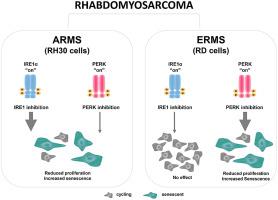Cancer Letters ( IF 9.7 ) Pub Date : 2020-07-15 , DOI: 10.1016/j.canlet.2020.07.009 Nicole McCarthy 1 , Nadezda Dolgikh 1 , Susan Logue 2 , John B Patterson 3 , Qinping Zeng 4 , Adrienne M Gorman 5 , Afshin Samali 5 , Simone Fulda 6

|
Rhabdomyosarcoma (RMS), the most common soft-tissue sarcoma, is associated with a low 5-year survival and harsh treatment side effects, underscoring an urgent need for therapy. The unfolded protein response (UPR) is activated in response to endoplasmic reticulum (ER) stress, where three ER stress receptors, IRE1, PERK and ATF6, aim to restore cellular homeostasis. The UPR is pro-tumourigenic in many cancers. In this study, we investigate basal UPR activity in RMS. Basal activation of IRE1 and PERK was observed in RMS cell lines, which was diminished upon addition of the IRE1 RNase inhibitor, MKC8866, or PERK inhibitor, AMGEN44. UPR inhibition caused a reduction in cell viability, cell proliferation and inhibition of long-term colony formation in both subtypes of RMS. Alveolar RMS (ARMS) subtype was highly sensitive to IRE1 inhibition, whereas embryonal RMS (ERMS) subtypes responded more markedly to PERK inhibition. Further investigation revealed a robust activation of senescence upon UPR inhibition. For the first time, the UPR is implicated in RMS biology and phenotype, and inhibition of UPR signalling reduces cell growth, suggesting that the UPR may be a promising target in RMS.
中文翻译:

展开的蛋白应答的IRE1和PERK臂促进横纹肌肉瘤细胞的存活。
横纹肌肉瘤(RMS)是最常见的软组织肉瘤,其5年生存率低和治疗副作用严重,这迫切需要治疗。未折叠的蛋白应答(UPR)响应内质网(ER)应激而激活,其中三个ER应激受体IRE1,PERK和ATF6旨在恢复细胞体内稳态。UPR在许多癌症中都是促肿瘤的。在这项研究中,我们调查了RMS中的基础UPR活性。在RMS细胞系中观察到了IRE1和PERK的基础活化,加入IRE1 RNase抑制剂MKC8866或PERK抑制剂AMGEN44后,这些活性减弱。在两种RMS亚型中,UPR抑制都会导致细胞活力降低,细胞增殖降低以及长期菌落形成受到抑制。肺泡RMS(ARMS)亚型对IRE1抑制高度敏感,而胚胎RMS(ERMS)亚型对PERK抑制的反应更为明显。进一步的研究表明,UPR抑制后衰老的激活作用强。UPR首次涉及RMS生物学和表型,并且对UPR信号的抑制会降低细胞生长,表明UPR可能是RMS中有希望的靶标。


























 京公网安备 11010802027423号
京公网安备 11010802027423号